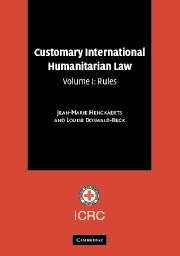Book contents
- Frontmatter
- Contents
- Foreword by ICRC President Jakob Kellenberger
- Foreword by Judge Abdul G. Koroma
- Foreword by Yves Sandoz
- Acknowledgements
- Introduction
- List of abbreviations
- Part I The Principle of Distinction
- Part II Specifically Protected Persons and Objects
- Part III Specific Methods of Warfare
- Part IV Weapons
- Chapter 20 General Principles on the Use of Weapons (Rules 70–71)
- Chapter 21 Poison (Rule 72)
- Chapter 22 Nuclear Weapons
- Chapter 23 Biological Weapons (Rule 73)
- Chapter 24 Chemical Weapons (Rules 74–76)
- Chapter 25 Expanding Bullets (Rule 77)
- Chapter 26 Exploding Bullets (Rule 78)
- Chapter 27 Weapons Primarily Injuring by Non-detectable Fragments (Rule 79)
- Chapter 28 Booby-traps (Rule 80)
- Chapter 29 Landmines (Rules 81–83)
- Chapter 30 Incendiary Weapons (Rules 84–85)
- Chapter 31 Blinding Laser Weapons (Rule 86)
- Part V Treatment of Civilians and Persons Hors De Combat
- Part VI Implementation
Chapter 25 - Expanding Bullets (Rule 77)
Published online by Cambridge University Press: 05 June 2012
- Frontmatter
- Contents
- Foreword by ICRC President Jakob Kellenberger
- Foreword by Judge Abdul G. Koroma
- Foreword by Yves Sandoz
- Acknowledgements
- Introduction
- List of abbreviations
- Part I The Principle of Distinction
- Part II Specifically Protected Persons and Objects
- Part III Specific Methods of Warfare
- Part IV Weapons
- Chapter 20 General Principles on the Use of Weapons (Rules 70–71)
- Chapter 21 Poison (Rule 72)
- Chapter 22 Nuclear Weapons
- Chapter 23 Biological Weapons (Rule 73)
- Chapter 24 Chemical Weapons (Rules 74–76)
- Chapter 25 Expanding Bullets (Rule 77)
- Chapter 26 Exploding Bullets (Rule 78)
- Chapter 27 Weapons Primarily Injuring by Non-detectable Fragments (Rule 79)
- Chapter 28 Booby-traps (Rule 80)
- Chapter 29 Landmines (Rules 81–83)
- Chapter 30 Incendiary Weapons (Rules 84–85)
- Chapter 31 Blinding Laser Weapons (Rule 86)
- Part V Treatment of Civilians and Persons Hors De Combat
- Part VI Implementation
Summary
Rule 77. The use of bullets which expand or flatten easily in the human body is prohibited.
Practice
Volume II, Chapter 25.
Summary
State practice establishes this rule as a norm of customary international law applicable in both international and non-international armed conflicts.
International armed conflicts
The prohibition in respect of international armed conflicts was introduced in 1899 by the Hague Declaration concerning Expanding Bullets in reaction to the development of the so-called “dum-dum” bullet for use in military rifles. The Declaration was ratified or acceded to by 28 States in the early years of the 20th century and 6 States succeeded to the Declaration in the second half of the 20th century. The use of expanding bullets is listed as a war crime in the Statute of the International Criminal Court. The prohibition has also been included in other instruments.
The prohibition of expanding bullets is set forth in numerous military manuals. The use of expanding bullets in armed conflict is an offence under the legislation of many States. The prohibition is also supported by official statements and other practice. This practice includes that of many States which are not party to the Hague Declaration.
Practice is in conformity with the prohibition and no State has asserted that it would be lawful to use such ammunition. The only exception to a complete prohibition of the use of expanding bullets is possibly the practice of the United States, although it is ambiguous.
- Type
- Chapter
- Information
- Customary International Humanitarian Law , pp. 268 - 271Publisher: Cambridge University PressPrint publication year: 2005

